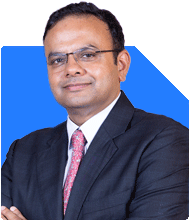Will I reach my 5-crore retirement goal with this portfolio?
Milind Vadjikar | Answer |Ask -Follow
Insurance, Stocks, MF, PF Expert - Answered on Feb 14, 2025
He has a mechanical engineering degree from Government Engineering College, Sambhajinagar, and an MBA in international business from the Symbiosis Institute of Business Management, Pune.
With over 16 years of experience in stock investments, and over six year experience in investment guidance and support, he believes that balanced asset allocation and goal-focused disciplined investing is the key to achieving investor goals.... more
.jpg)
I am 42 years younger and have following Funds (all direct growth) in my portfolio current value is of around 11 Lakhs: PPFAS - 10k Motilal Midcap - 6k Motilal Midcap Index-8k NIMF-Smallcap-9k HDFC NIFTY 50 Index - 6k Uti Nifty 50 - 6k HSBC Nifty 50 - 5K I am planning to do step up yearly as much as I can, aiming to make 55K next year in January. Can you please help in analysing/review this folio, are they good for long term ~19-20 years, purpose is for retirement goal is to reach 5cr with this folio only? -I am also saving in PPF and SSY maxing out monthly limit. -I am starting from this month a separate Folio for my Daughter for around ~10 years of 10K investing in Motilal Midcap Index (2K) and UTI Nifty 50 (8K). Please advise.
My view is that you may replace midcap fund with large and midcap fund.
Also small cap fund may be replaced with multicap fund.
Your intent to step up sip every year is a positive thing. Minimum 7-10% of sip step up should be targeted.
Your target with the step up sip for 20 years seems quite achievable.
Good to note your commitment to PPF and SSY investments.
For your kid you may make sip into a single aggressive hybrid fund.
Best wishes;
X: @mars_invest
You may like to see similar questions and answers below
Ulhas Joshi |280 Answers |Ask -Follow
Mutual Fund Expert - Answered on Jun 20, 2023
Abhishek Dev | Answer |Ask -Follow
Financial Planner - Answered on Oct 03, 2023
Ramalingam Kalirajan |10893 Answers |Ask -Follow
Mutual Funds, Financial Planning Expert - Answered on Oct 21, 2024
Ramalingam Kalirajan |10893 Answers |Ask -Follow
Mutual Funds, Financial Planning Expert - Answered on Nov 26, 2024
Ramalingam Kalirajan |10893 Answers |Ask -Follow
Mutual Funds, Financial Planning Expert - Answered on Mar 25, 2025
Nitin Narkhede |113 Answers |Ask -Follow
MF, PF Expert - Answered on Dec 15, 2025
Nitin Narkhede |113 Answers |Ask -Follow
MF, PF Expert - Answered on Dec 15, 2025
Ramalingam Kalirajan |10893 Answers |Ask -Follow
Mutual Funds, Financial Planning Expert - Answered on Dec 15, 2025
Ramalingam Kalirajan |10893 Answers |Ask -Follow
Mutual Funds, Financial Planning Expert - Answered on Dec 15, 2025
Radheshyam Zanwar |6746 Answers |Ask -Follow
MHT-CET, IIT-JEE, NEET-UG Expert - Answered on Dec 15, 2025
Ramalingam Kalirajan |10893 Answers |Ask -Follow
Mutual Funds, Financial Planning Expert - Answered on Dec 15, 2025
Ramalingam Kalirajan |10893 Answers |Ask -Follow
Mutual Funds, Financial Planning Expert - Answered on Dec 15, 2025
Ramalingam Kalirajan |10893 Answers |Ask -Follow
Mutual Funds, Financial Planning Expert - Answered on Dec 15, 2025
Samraat Jadhav |2508 Answers |Ask -Follow
Stock Market Expert - Answered on Dec 15, 2025
Ramalingam Kalirajan |10893 Answers |Ask -Follow
Mutual Funds, Financial Planning Expert - Answered on Dec 15, 2025




























